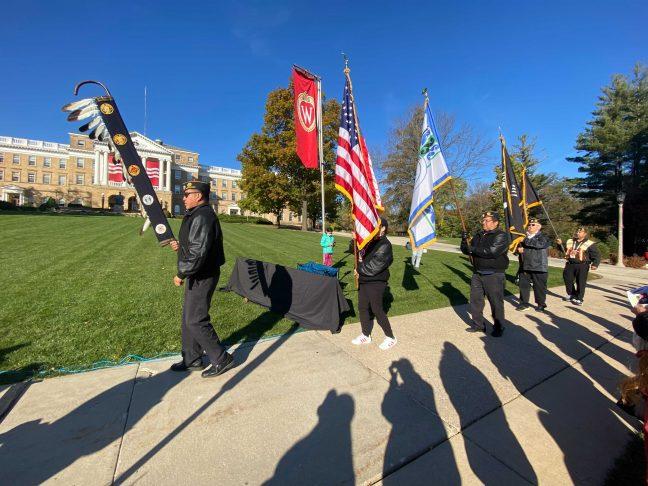The Ho-Chunk Nation flag will fly above Bascom Hall for longer than six weeks during the fall in an effort to educate campus members about Ho-Chunk culture and First Nations history.
The effort started with a public flag-raising ceremony Sept. 15. Following the ceremony, the Ho-Chunk Nation flag flew for one week in September. The flag will fly again for Indigenous Peoples Day Oct. 10 through Oct. 17 and for the entirety of National Native American Heritage Month in November, according to UW News.
The University of Wisconsin occupies ancestral Ho-Chunk land called Teejop, according to UW News. Agricultural practices and construction throughout the past 150 years destroyed many archaeological sites. As a result, only four mound groups are visible on campus, according to the Lakeshore Nature Preserve. The Ho-Chunk Nation takes care of the remaining mounds, according to UW News.
UW first made history by raising the Ho-Chunk Nation flag above Bascom Hall for one day in November 2021. Both the U.S. flag and the Wisconsin flag flew on the same flag pole, according to UW News.
This approach, according to Ho-Chunk president of the Indigenous Law Students Association Morgan Spohn, was very strange as the U.S., Wisconsin and the Ho-Chunk flag flew on the same flag pole at the time. Spohn hopes the Sept. 15 ceremony will rectify some wrongs with the addition of a new flag pole.
“They had a big U.S. flag and the state of Wisconsin flag,” Spohn said. “Then you look at the Ho-Chunk flag and it’s small and below both of them. I think it’s weird because we are a sovereign nation; in the context of how people would view it, you’re below the state. Having [the flags] on one pole I think upset a lot of people.”
The new chancellor provides a lot of hope for not just Ho-Chunk people but Native people in general, Spohn said.
During her time as the Dean of the School of Law at the University of California, Los Angeles, Spohn said Chancellor Jennifer Mnookin highlighted Native people, scholars and students.
“Being a Ho-Chunk person, that shows that she is there to make sure that we are successful in the education realm but also that we have the support behind us,” Spohn said.
Spohn said the Sept. 15 flag-raising ceremony and efforts planned throughout the fall semester are very impactful. In fact, it’s the most Spohn’s seen from the university since being an undergraduate in 2017.
Flag raising ceremonies, like the event at UW, hold a significant cultural meaning to the Ho-Chunk, Public Relations Officer for the Ho-Chunk Nation Casey Brown said. Despite the Ho-Chunk residing in Madison since the Ice Age, the flag dates back to a government reform in the 1990s.
“The flag represents that sort of rebirth, reforming and rethinking [of] our claim as an indigenous nation, a sovereign nation within the United States,” Brown said. “For us, to have that flag in Madison is a symbolic reminder of who we are, what we are and where we’re going.”
Though the Ho-Chunk flag will fly for more than six weeks this semester, ultimately there are no flags in Bascom Hall, Spohn said.
Spohn hopes to one day see the flags of the 12 sovereign nations of Wisconsin in Bascom Hall. But he views progress as a ladder — people expect to go from the bottom to the top in one jump, but there are a lot of steps in between.
The Ho-Chunk flag-raising ceremonies are a long time coming, Spohn said. Still, he believes having the flags up for a whole year would be monumental.
“We’ve all hated climbing Bascom Hall or walking [around] campus, and you see that one thing on campus that kind of just gets you through it,” Spohn said. “For a lot of people, that’s different locations. I feel like not only for a Ho-Chunk person, but for a Native person, seeing a tribal flag on top of Bascom Hall would get you through a hard day.”
In an effort to help university staff, faculty and students learn more about the 12,000-year human story of Madison, UW created the Our Shared Future initiative in 2019, according to Director of Tribal Relations and co-lead of Our Shared Future Aaron Bird Bear.
“Most of our students did not receive education about the history, culture or tribal sovereignty of the Native Nations of Wisconsin, including the Ho-Chunk Nation,” Bird Bear said. “The Our Shared Future initiative was designed to help educate our campus about the specialness of this place and about the Ho-Chunk people, culture and history.”
Four out of five U.S. citizens know little to nothing about Native Americans, Bird Bear said. In line with this, UW found that the vast majority of students, faculty and staff reflect this lack of understanding, according to Bird Bear.
But, this is not a coincidence.
“The organizing principle and goal of all settler colonial societies, including the United States, Canada, New Zealand [and] Australia, is replacement,” Bird Bear said. “Part of that replacement goal includes not educating the citizenry about the society that existed prior to colonization.”
This goal also involved renaming everything, according to Bird Bear.
What is known as Lake Mendota today was once called Lake Waaksikhomik to the Ho-Chunk Nation. This name referenced the water spirit and the lake, along with the Ho-Chunk view of the human connection to water, Bird Bear said.
“UW-Madison is considered the most archaeologically rich campus in the United States,” Bird Bear said. “If your creation story says you’ve always been from here and yet most of our student body [doesn’t] know that, it’s very challenging to be kind of erased in that way from the fabric of our institutional community.”


